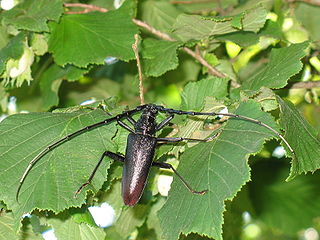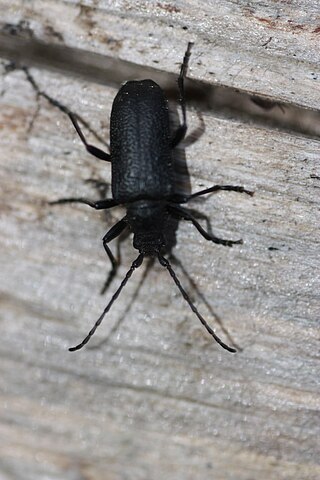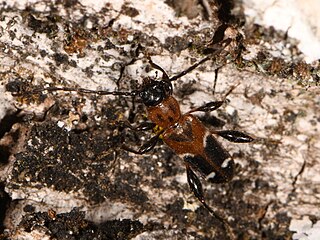
Cerambyx is a genus of beetles in the family Cerambycidae. They are commonly known as capricorn beetles, as their strong, stout and curved antennae, each segment of which flares towards the tip, are reminiscent of the horns of an Alpine Ibex or "capricorn".

Necydalinae is a small subfamily of the longhorn beetle family (Cerambycidae), historically treated as a tribe within the subfamily Lepturinae, but recently recognized as a separate subfamily. These beetles are unusual for cerambycids, in that the elytra are quite short; they are thus rather similar in appearance to rove beetles, though most are actually bee or wasp mimics.
Anthophylax cyaneus is a species of Long-Horned Beetle in the beetle family Cerambycidae. It is found in Canada and United States of America.
Neanthophylax mirificus is a species of Long-Horned Beetle in the beetle family Cerambycidae. It is found in North America, Costa Rica, and Mexico.
Neanthophylax pubicollis is a species of Long-Horned Beetle in the beetle family Cerambycidae. It is found in United States.

Neanthophylax tenebrosus is a species in the longhorn beetle family Cerambycidae, found in United States. The adult beetles feed on mountain hemlock and red fir.

Dorcasominae is a subfamily in the longhorn beetle family Cerambycidae. There are about 14 genera and more than 30 described species in Dorcasominae, found mainly in Asia and Africa. These genera are sometimes considered members of the tribe Dorcasomini, which would be the only tribe of this subfamily. This classification is in accordance with the TITAN Cerambycidae database, Catalogue of Life, and Photographic Catalog of the Cerambycidae of the Old World. It is similar to that of Bouchard et al. in "Family-group names in Coleoptera", 2011.

Neandra is a genus of Long-Horned Beetles in the beetle family Cerambycidae. There are at least two described species in Neandra.

Neanthophylax is a genus in the longhorn beetle family Cerambycidae. There are at least four described species in Neanthophylax.

Atiaia is a genus of Long-Horned Beetles in the beetle family Cerambycidae. There are at least two described species in Atiaia.

Butherium is a genus of Long-Horned Beetles in the beetle family Cerambycidae. This genus has a single species, Butherium erythropus. It is found in Brazil, Ecuador, Argentina, Paraguay, and Bolivia.
Cevaeria is a genus of Long-Horned Beetles in the beetle family Cerambycidae. This genus has a single species, Cevaeria estebani. It is found in Bolivia and French Guiana.

Criodion is a genus of Long-Horned Beetles in the beetle family Cerambycidae. There are about 11 described species in Criodion.
Plocaederus is a genus of Long-Horned Beetles in the beetle family Cerambycidae. This genus has a single species, Plocaederus bellator. It is known from the South American countries Brazil, Ecuador, Guyana, French Guiana, Paraguay, and Suriname.

Sphallotrichus is a genus of beetles in the family Cerambycidae, containing the following species:
Aleiphaquilon is a genus of Long-Horned Beetles in the beetle family Cerambycidae. There are about nine described species in Aleiphaquilon, found in South America.

Phymatodes obliquus is a species of longhorn beetle in the family Cerambycidae. It is found Pacific coastal area of North America and Baja California.

Phymatodes varius is a species of longhorn beetle in the family Cerambycidae. It is found in North America.
Baraeus subvittatus is a species of beetle in the family Cerambycidae. It was described by Stephan von Breuning in 1955. It is known from Cameroon.
Pachybrachis subvittatus is a species of case-bearing leaf beetle in the family Chrysomelidae. It is found in North America.










